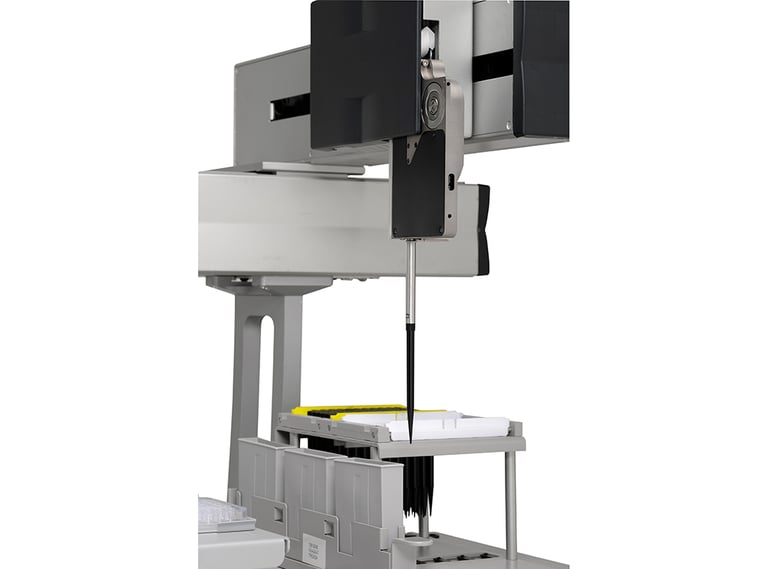Keywords:
By Mellisa Enriquez
Molecular diagnostics: the never-ending challenge
Molecular diagnostics offers researchers and clinicians valuable insights into the mechanisms of disease, allowing them to assess predisposition, as well as to design and implement accurate diagnostic methods and individualized therapies.

However, the combination of high throughput, complex workflows with small liquid volumes, plus sensitivity to contamination and carry-over, means that molecular diagnostics techniques – and hence instruments – are constantly pushing technological boundaries. So where are we now, and can we make the life of an instrument developer any easier?
From Cavro ADP to ADP Detect
The challenges outlined above mean that using OEM liquid handling solutions to facilitate molecular diagnostics instrument development is fundamental to accelerating time-to-market, even when there is in-house automation expertise. To this end, Tecan’s reputation in liquid handling and sample preparation means that its Cavro® product family, which includes a wide range of pumps and pipettors, has been a favorite with design engineers for decades. The need for a compact, programmable pipetting module led to the launch of the Cavro Air Displacement Pipettor (ADP) in 2011, and to the development of the latest addition to Tecan's OEM liquid-handling portfolio, the Cavro ADP Detect.
Cavro ADP: portrait of a pipette
Molecular diagnostics workflows require extremely precise, accurate and reproducible pipetting, with even small errors leading to inconsistent or inaccurate results. This was a key driver in the development of Cavro ADP, one of the smallest and most sophisticated air displacement pipettors on the market, combining advanced pipetting, process security and tip eject functionalities in a single unit. Designed for easy integration into compact instruments, it is ideal for applications that use disposable tips to prevent carry-over or contamination.
The Cavro ADP streamlines the pipetting workflow and enhances process security by eliminating the need for priming, washing, and cleaning steps, reducing the hardware requirements (tubing, bottles, and system liquid reservoirs) and ultimately simplifying maintenance. Its slim profile allows 18 mm spacing for microplate-based testing, and it offers manufacturers a chance to reduce costs without compromising on pipetting performance.
Why use air displacement pipettes?
The combination of air displacement pipetting and disposable tips used in the Cavro ADP virtually eliminates the chance of carry-over, as there is an air cushion between the piston and the sample, so they are never in direct contact, compared with positive displacement (Figure 1).
Figure 1: Cavro ADP uses air displacement (right), which minimizes the potential for contamination and carry-over compared with positive displacement (left).
Disposable tips and tricks
Most molecular diagnostics workflows rely on the use of disposable tips to avoid carry-over, creating a risk that tips may fail to attach properly or simply fall off, plus, there is an obvious need for automated tip pick-up and ejection mechanisms. The Cavro ADP features a built-in sensor to confirm tip pick-up and eject, automatically flagging if a tip has not been picked up or has fallen off during processing.
We’ve covered how the Cavro ADP uses air displacement and minimises the risks involved with the use of disposable tips, but how does it detect the liquid levels in the samples and reagents that it pipettes? This is where its apparent “sixth sense” comes into play.
cLLD versus pLLD: an acronym deep dive
Accurate pipetting requires the pipette tip to be submerged below the surface of the liquid during aspiration, so ideally pipettes would have built-in liquid level detection (LLD) that monitors the level of the liquid in a system, to ensure that the pipettor stops at or near the surface of the liquid. This not only avoids aspirating air, but also reduces the risk of pipetting inaccuracies caused by liquid clinging to the outside of the tip. The Cavro ADP offers two sorts of liquid level detection, either or both of which may be suited to a given application.
1. On-board pressure-based liquid level detection (pLLD) is based on detecting a change of pressure within the tip, indicating that the open end of the tip is contacting liquid. The sensor data is used to determine how far to insert the probe. For liquid handling applications where cross-contamination is a concern, or capacitive liquid-level detection cannot be used (see below), pLLD is often the method of choice.
2. By contrast, capacitive-based liquid level detection (cLLD) works by sensing a change in capacitance (electric charge). This method is based on the principle that liquids generally have dielectric constants that are significantly different from that of air. When a conductive tip or probe contacts liquid, the capacitance of the liquid is added to the capacitance of the probe, and the cLLD circuitry detects this change of capacitance. An electronic circuit called a capacitance bridge is used to detect when the probe touches the surface of the liquid, minimizing contamination of the outside of the tip that could impact performance.
Either or both liquid level detection methods may be more suited to the common sample types that can lead to pipetting issues (see Figure 2) and depending on the exact combination of variables, you may be better choosing one or a combination of cLLD and pLLD. This is discussed in more detail in the accompanying white paper, so you can clarify which method best suits your application.
Calling up Cavro ADP Detect
Once the liquid level is known, and pipetting begins, the Cavro ADP Detect addresses many potential concerns that a user may have about the accuracy of the liquid volume.
Put simply, the Cavro ADP Detect has a built-in algorithm that identifies pressure curve anomalies quickly and accurately during aspiration. This feature allows the user to have confidence that the aspiration of liquid from its source well has completed successfully, without any of the common problems shown below that could lead to inaccurate volumes of liquid being aspirated into the disposable tip (Figure 2). The ADP features a robust command set which allows a wide range of parameters to be defined by the user. Both the ADP and ADP Detect supports two most used communication interfaces – Serial (RS485) and CAN for component integration.
.png?width=768&height=587&name=Figure%202%20(2).png)
Figure 2: Primary applications that require enhanced process security, along with common situations that can lead to pipetting issues
Maintaining Cavro ADP in the molecular diagnostics landscape
Tecan Cavro ADP pipettors are used in a range of molecular diagnostics applications around the world, offering a proven track record of successful integration into molecular diagnostics platforms, with Cavro ADP Detect gaining acceptance in today’s development projects.
Both the Tecan Cavro ADP and ADP Detect are designed to be maintenance-free and are factory-calibrated to guarantee the most accurate pipetting performance, with air volume calibration protocols to ensure ongoing precision. Each device uses high quality, long-life components – with a life expectancy of over 5 million cycles for the drive mechanism – ensuring continuous hassle-free operation.
Finally, diagnostic instrument designers and manufacturers benefit from the fact that all Tecan Cavro OEM pumps and devices, including the Cavro ADP, meet the requirements for ISO13485 compliance, ISO9001 and FDA 21 CFR Part 820 standards. The use of such pre-approved OEM modules in the initial instrument design dramatically reduces risk throughout the entire instrument lifecycle by simplifying and speeding up overall regulatory approval, accelerating time-to-market for cutting-edge molecular diagnostics instruments.
And so we end by answering our initial question: yes, we can make the life of the instrument developer easier, even when it comes to that most boring yet essential of operations – pipetting – with the addition of Cavro ADP Detect to their design toolbox. To learn more about the Cavro ADP technology behind this story, and see what users have to say about Tecan’s OEM automated liquid handling solutions, we invite you to download our white paper, and find out just how easily the Cavro ADP can help you to streamline and accelerate your own instrument development.
Keywords:
About the author

Mellisa Enriquez
Mellisa is currently the Senior Product Marketing Manager for Tecan’s Cavro robotic and pipetting components. She has over five years of instrument and consumable product development and marketing experience. Her current focus is on developing new technologies for diagnostics and -omics instrumentation.











.jpg?width=768&height=432&name=Figure%201%20(2).jpg)
